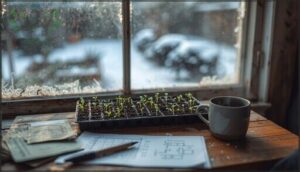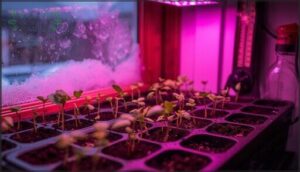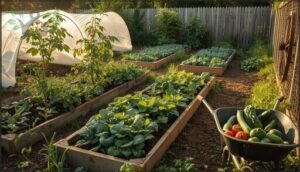This site is supported by our readers. We may earn a commission, at no cost to you, if you purchase through links.
Most gardeners lose about 20% of their potential harvest because they plant two weeks too early or too late. That’s not bad luck. That’s a misalignment with what the soil and climate are actually ready to give. Your tomatoes need 13°C ground temperature to germinate properly. Your peas will rot if you wait until mid-May. The difference between a thriving crop and a struggling one often comes down to a single week.
A seasonal planting guide removes the guesswork by matching your seed packets to frost dates, soil warmth, and daylight patterns in your specific zone. When you plant what your region can support at the exact moment conditions align, you stop fighting nature and start working with it.
Table Of Contents
Key Takeaways
- Planting at the precise moment when soil temperature, frost dates, and daylight hours align with each crop’s needs can boost yields by up to 24% and prevent disease by 17%, turning timing from guesswork into measurable advantage.
- Your USDA hardiness zone sets the foundation, but real success comes from tracking actual soil warmth (13°C for tomatoes, 4°C for carrots) and local frost dates—not generic calendars that ignore your specific microclimate.
- Succession planting every 10–14 days and matching crop maturity windows to your growing season transforms a single harvest into 20+ weeks of continuous production without expanding your garden footprint.
- Soil preparation between seasons through testing, composting, and crop rotation prevents nutrient depletion and pest cycles, making each planting more resilient than the last without synthetic inputs.
Why Timing Matters in Seasonal Planting
Planting at the right time separates thriving gardens from disappointing ones. Your timing directly controls whether plants establish strong roots, resist pests, and produce abundant harvests.
Understanding these three core principles puts you in command of your garden’s success from seed to table.
Benefits of Following Planting Calendars
Following a planting calendar puts you in control of your garden’s success. You’ll avoid guesswork and make confident decisions backed by climate data and proven timing. Regional planting guides matched to the USDA Plant Hardiness Zone Map ensure consistent harvests and protect your investment.
- Crop yield increase: Early planting aligned with your gardening calendar can boost yields by up to 24% for crops like spring wheat.
- Farm profitability: Following recommended schedules reduces input costs—irrigation and pest control—by up to 15%.
- Disease prevention: Region-specific timing cuts disease incidence by 17% and reduces pesticide days by 33%.
- Resource efficiency: Proper scheduling improves seed germination by 8–14% and reduces water runoff by 19%.
- Climate adaptation: Calendars help you shift sowing dates for changing weather patterns, lowering frost damage risk by 16%.
Using a planting calendar guide is essential for determining the best times to plant and harvest crops.
Impact of Timing on Harvest Yields
Timing your planting schedule dictates how much you’ll harvest. Plant corn between April 25 and May 10, and you’ll hit peak yield optimization. Miss that window? Expect losses.
Soybeans decline 0.33% per day after mid-May—jumping to 1.2% daily by June. Delayed planting pushes grain filling into brutal heat, cutting yields by 12% or more.
Delay soybean planting past mid-May and watch yields hemorrhage—first 0.33% daily, then 1.2% as heat crushes production
Your harvest timing isn’t luck—it’s precision. Understanding essential soybean planting strategies is vital for maximizing yields.
Risks of Planting Too Early or Late
Plant too early and you’re gambling with frost damage. Soybeans can lose 10-20% emergence when cold soil hits—temperatures below 30°F kill emerged seedlings outright. Late planting isn’t safer.
Corn yields drop 0.3-1% daily after mid-May as crop failure risks mount. Soil erosion, plant stress, and disease pressure spike when you ignore frost dates and climate zones.
Your days to harvest shrink. Yield reduction follows.
Key Factors Affecting Planting Schedules
You can’t just pick a date and start planting. Your garden answers to forces bigger than your enthusiasm—frost, soil warmth, sunlight, and the rhythm of your region’s growing season.
Let’s break down the factors that actually determine when your seeds hit the ground.
Frost Dates and Climate Zones
Your garden’s success hinges on knowing two critical numbers: when your last spring frost hits and when the first fall freeze arrives. The USDA Plant Hardiness Zone Map breaks North America into 13 zones based on minimum winter temperatures. Each zone dictates frost tolerance requirements.
Climate shifts have extended growing seasons by roughly two weeks since 1895, pushing spring frost dates earlier and fall frosts later across most regions.
Soil Temperature and Moisture
Beyond frost dates, your seeds answer to soil temperature and moisture—two signals that determine whether they’ll germinate or rot in the ground. Cool-season crops like cabbage and carrots wake up at 4°C (40°F), but warm-season staples need 13–16°C (55–60°F) minimum. Plant into cold, wet soil and you’re rolling the dice with Pythium and Fusarium.
- Soil sensors and irrigation systems let you monitor moisture levels in real time
- Loam soils hold 20–30% water at field capacity; sandy types retain only 10–15%
- Each 1% boost in organic matter adds 1.3 cm of water-holding capacity per 30 cm depth
- Cold, saturated seedbeds delay emergence and invite root rot pathogens
- Soil composition and soil type shape temperature control strategies across every climate zone
Daylight Hours and Humidity
When day length drops below 10 hours, most plants shut down active growth—regardless of temperature. That’s why your tomatoes stall in autumn and why you need climate sensing to time warm-season transplants.
Humidity control matters too: 80% relative humidity drives peak growth rates in greenhouses, while storage above 75% ruins seed viability.
Master daylight effects and seasonal variance, and your seasonal planting guide unlocks year-round harvests across any climate zone.
Regional Growing Windows
Your regional window determines every planting decision you make. USDA Plant Hardiness Zones divide areas by minimum temperature, but actual growing seasons vary wildly within zones:
- Coastal Maryland enjoys 200+ days of frost-free growth while nearby mountains get only 140
- Southern states start planting peas in late February; Zone 10 never stops
- Midwest growers wait for 40°F soil before seeding cold-tolerant crops
Know your frost dates and harvest periods—that’s regional gardening mastery.
Seasonal Planting Guide: Month-by-Month
Your garden doesn’t run on a generic schedule—it runs on the rhythm of your local climate and the specific needs of each crop. The months ahead will walk you through what to plant and when, starting with the quiet planning of January and building up to the main action of spring.
Here’s how to navigate each month so you’re always one step ahead of the season.
January – Planning and Indoor Prep
While frost still grips the ground, your growing season actually starts now. January is all about seed starting indoors and garden planning.
53% of home gardeners order seeds this month to get ahead. You’ll prep layouts, start brassicas and greens in trays, and adjust your planting guides for climate shifts.
Early prep means harvests up to 35 days sooner and stronger transplants come spring.
February – Early Starters and Seedlings
February separates planners from dreamers—this is when seedling care becomes real action. Indoor sowing of lettuce, brassicas, and cherry tomatoes now means harvests four weeks earlier. You’ll need grow lights to cut leggy growth by 62%. Here’s what thrives in February’s controlled warmth:
- Lettuce and arugula—90%+ germination in two days
- Broccoli, cabbage, kale—79% transplant survival
- Cherry tomatoes—ready by June with 120-day varieties
- Leeks—80% germination for spring planting dates
- Early carrots outdoors in zones 7+—starts at 40°F
Keep soil at 60–70% moisture and 60–65°F for best root development. Frost protection remains critical if you’re tempted to transplant early. Plant hardiness zones shifted north recently, so adjust your seed selection accordingly.
This seasonal planting guide phase builds the foundation for spring’s bounty through strategic winter gardening and proper timing by region.
March – Outdoor Sowing and Cool Crops
Once your soil hits 45°F, you’re clear to plant your first wave of freedom crops. March outdoor sowing transforms your winter planning into tangible food security with spinach, peas, and kale—crops that laugh at late frosts and thrive in cool conditions.
| Cool Crop | Min. Soil Temp | Frost Tolerance | Days to Harvest | Zone Sowing |
|---|---|---|---|---|
| Spinach | 45°F | Survives 20°F | 30–45 | 5–10 |
| Peas | 45°F | Hardy to 25°F | 55–70 | 5–10 |
| Carrots | 45°F | Tolerates light frost | 60–80 | 5–10 |
| Kale | 45°F | Survives hard frost | 50–65 | 5–10 |
| Beets | 50°F | Moderate tolerance | 50–70 | 5–10 |
Your spring planting dates hinge on frost risk. In Maryland and similar zones, expect a 90% freeze probability through late March. That’s not a threat for hardy cool crops. Direct-sow these survivors when daytime temperatures stay above 50°F consistently. Soil temperature matters more than air temperature for germination success.
Plant hardiness zones guide your crop rotation strategy, but soil prep determines your yields. Beets can deliver 14,000 pounds per acre under ideal March conditions. Carrots average 100 pounds per 100-foot row when you time it right.
This seasonal planting guide phase separates cautious gardeners from those who understand that gardening by region means embracing March’s unpredictable weather as an advantage for cool crops.
April – Main Season Planting
When soil temperatures reliably hit 50°F, you’ve reached your peak window for corn, soybeans, and summer squash—crops that define your harvest planning for the year. Spring seasonal planting in April means you’re working with 12+ hours of daylight and declining frost risk across most zones.
University studies confirm corn planted late April to early May delivers optimum yields, while each day delayed past May 15 costs you 0.4% in production. Your seasonal planting guide hinges on this month’s decisions.
May – Warm-Season Crops and Transplants
May launches your warm-season vegetables into high gear once soil temperatures hold steady at 68–86°F. You’re transplanting tomatoes, peppers, and eggplants after nighttime lows stay above 50°F—planting strategies that protect against frost risks and boost crop yields. Your gardening by season playbook now includes:
- Direct-sow beans when soil hits 70°F minimum
- Transplant melons for September harvests
- Stagger sweet corn every 7–10 days
- Plant okra between May 20–July 10
- Monitor transplant timing for continuous production
Regional and Zone-Based Planting Tips
Your garden won’t thrive if you’re working from the wrong playbook. Every climate zone has its own rules, and what works in Georgia will fail in Montana.
Let’s break down how to find your zone, adjust your schedule, and use real-world examples to plant with confidence.
Using The USDA Plant Hardiness Zone Map
Before you break free from guesswork, you need the right map. The USDA Hardiness Zone assigns your location a rating based on average winter lows—your first step in gardening strategies that actually work. Enter your zip code on the USDA site to find your zone, then match plants to those hardiness ratings for real plant survival.
| Zone | Winter Low (°F) | Example Crops |
|---|---|---|
| Zone 3 | −40 to −30 | Garlic, asparagus |
| Zone 4 | −30 to −20 | Carrots, kale |
| Zone 8 | 10 to 20 | Watermelons, tangerines |
| Zone 10–13 | 30+ | Citrus, tropical fruits |
Climate classification through zone mapping transforms chaos into clarity. You’ll see exactly which perennials survive your winters and which warm-season crops thrive. The 2023 update used over 13,000 weather stations for pinpoint accuracy, so trust the data.
Pair this seasonal planting guide intel with frost dates, and you’re controlling your harvest—not hoping for it.
Adapting Schedules for Different Climates
Your zone’s just the starting point—real climate adaptation means reading temperature thresholds and moisture patterns.
In regions above 30°N, you’re playing with temperature-driven shifts; spring planting windows can advance 10 to 30 days as you work with warming trends.
Tropics? Follow the rain. Seasonal flexibility wins when you sync your seasonal planting guide moves with actual soil conditions, not rigid dates.
Examples From Various Regions (e.g., Maryland, Southern US, Bihar)
Let’s get real: regional crop patterns shift dramatically across climate variability zones. Maryland’s 170 frost-free days mean you’re planting tomatoes late April. Southern US zones stretch that window—corn and peas start late February. Bihar’s monsoon-driven soil moisture management flips the script entirely: wheat in November, rice in June. Here’s how frost date strategies break down by geography:
- Maryland (Zone 7): Cool-season starts align with April’s 10% freeze risk threshold
- Southern US (Zones 7-8): Double harvests possible with 7-8 month frost-free seasons
- Bihar Kharif: Maize planted May 15–June 15, harvested mid-August using monsoon water
- Bihar Rabi: Wheat sown November, relies on residual moisture through April
- Zone 10: Winter lettuce thrives when summer heat would destroy cool crops
Your seasonal planting guide needs geographic planting tips rooted in actual plant hardiness zones—not generic advice that ignores climate and zone gardening realities.
Finding Local Frost Dates and Recommendations
How do you lock down accurate frost dates when climate shifts blur traditional planting windows? Start with your ZIP code in USDA plant hardiness zone calculators or gardening apps like SeedTime. County extension offices provide localized frost date tools adjusted for recent climate shifts.
Pair these with soil monitoring—track actual ground temperature, not just air frost predictions—to fine-tune your seasonal planting calendar and gardening schedule.
Maximizing Harvests With Planting Strategies
You’ve got your calendar set and your frost dates locked in. Now it’s time to turn that knowledge into actual food on your table.
The strategies below will help you stretch your harvest season, protect what you’ve planted, and keep your garden producing from first thaw to final freeze.
Succession Planting for Continuous Yield
Succession planting puts you in command of your harvest window. Instead of one big wave of lettuce in spring, sow every 10–14 days for 20 weeks of continuous greens.
Fast-maturing crops like radishes and bush beans thrive under this approach. Strategic spacing and rapid bed turnover keep your ground producing all season.
Think of it as staggered reinforcements—your garden never goes dark.
Crop Selection and Days to Maturity
Match your crop selection to your actual growing window—that’s the rebellion. Days to maturity (DTM) tells you how long from seeding or transplant to harvest.
Short-season climates demand varieties maturing in 60–80 days. Select early beans at 55 days or mid-season tomatoes at 70.
Mix maturity rates within each crop for staggered harvest timing and better climate adaptation across your plant hardiness zones.
Soil Preparation Between Seasons
Between crops, your soil needs replenishment—not rest. Conduct soil testing each season to identify nutrient gaps and adjust amendments. Add compost application to rebuild organic matter depleted by harvests, which boosts microbial balance and nutrient cycling by up to 25%.
Rotate crops strategically to disrupt pests and preserve soil health. This gardening planning and preparation transforms tired ground into a powerhouse for seasonal planting success.
Mulching and Frost Protection Techniques
Frost Protection and Management can make or break winter crops. Mulching shields roots from freeze damage while stabilizing soil temperature swings—bare soil fluctuates 26°C compared to just 6.7°C under mulch.
Apply these Winter Preparation strategies for Climate Resilience:
- Layer three inches of Mulch Materials between December and February after checking local Frost dates
- Choose pine bark or cypress for slow decomposition
- Space applications to regulate moisture and insulation
- Monitor soil under mulch during extreme cold snaps
This Seasonal Planting essential improves Soil Insulation and boosts survival rates markedly.
Frequently Asked Questions (FAQs)
How do I rotate crops to prevent soil depletion?
Rotate crops by alternating plant families each season—legumes add nitrogen, deep-rooted crops break compaction, and cover crops boost organic matter.
This cycle prevents nutrient depletion while naturally suppressing pests and diseases through sustainable practices.
What natural fertilizers work best for each season?
The best fertilizer weakens your soil if applied at the wrong time. Spring compost delivers nitrogen for leafy growth, while summer manure fuels fruiting crops. Fall mulching rebuilds winter humus, promoting sustainable gardening and ideal soil health year-round.
Which companion plants improve growth and pest control?
You can pair basil with tomatoes to cut aphid problems by 30-40%. Marigolds repel pests while borage boosts strawberry yields by 35%. Companion planting strengthens crop diversity and biological balance naturally.
How do I extend growing seasons with greenhouses?
You can extend your growing season by up to 67% with greenhouses. They provide climate control and frost protection while reducing water use by 70–90%, enabling year-round harvests through optimized greenhouse design and energy efficiency.
What watering schedules suit different seasonal crops?
Crop water needs shift with seasons. Spring vegetables need 1–2 inches weekly. Summer irrigation doubles in heat. Fall reduces watering by 30%.
Match your schedule to growth stage and soil moisture for real conservation.
Conclusion
The irony? Most gardeners overcomplicate what plants have been doing for millennia—responding to temperature, light, and soil.
Your seasonal planting guide isn’t about mastering complexity. It’s about stepping back and letting the calendar do the heavy lifting. Match your seeds to frost dates. Wait for warm soil. Plant in sync with your zone.
The garden doesn’t need you to outsmart it. It needs you to stop working against it and finally listen.
- https://farmdocdaily.illinois.edu/2022/04/what-do-we-know-about-planting-dates-and-corn-and-soybean-yield-from-agronomic-field-trials.html
- https://www.pubs.ext.vt.edu/426/426-331/426-331.html
- https://news.climate.columbia.edu/2022/01/27/how-climate-change-will-affect-plants/
- https://www.ufseeds.com/maryland-vegetable-planting-calendar.html
- https://pmfby.gov.in/pdf/New_Crop_Calendar_20.09.18.pdf












